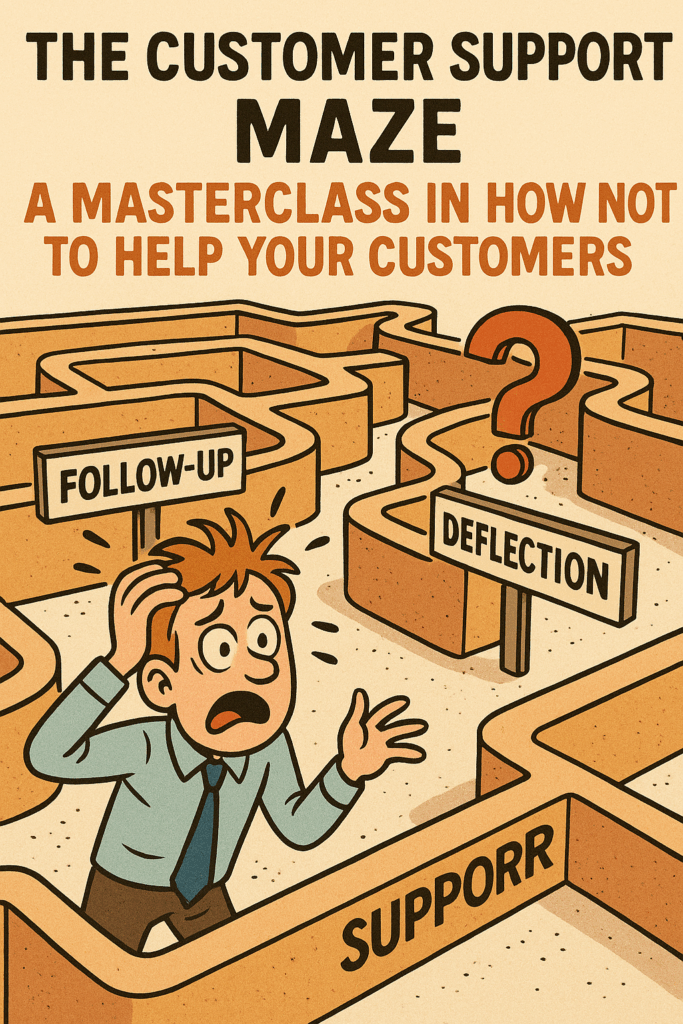THINGS OF LIFE – The Support Maze
The Customer Support Maze: A Masterclass in How Not to Help Your Customers
We’ve all been there.
You buy a product, it doesn’t work—and instead of a solution, you’re handed a ticket to a bureaucratic obstacle course.
In this post, I break down a real-world experience that reveals the absurdity (and hidden costs) of modern customer support. Spoiler: you’re the one funding the dysfunction.
Why are we paying premium prices to subsidize our own frustration?
Picture this: You’ve just bought a brand-new refrigerator. It arrives… dead on delivery. In a rational world, the solution is simple—the seller sends a replacement.
Instead, you’re dropped into a Byzantine bureaucracy that would make Kafka proud. This real-world scenario is a perfect case study of what’s broken in modern customer support.
🌀 The 6-Step Journey to Nowhere
🔄 Step 1: The Great Deflection
You contact the seller expecting a basic exchange.
Response: “That’s not our department. Please contact the manufacturer.”
The same company that eagerly took your money —and handed you a 12-page assembly manual— now develops selective amnesia about responsibility.
🔄 Step 2: The Manufacturer’s Shell Game
You call the manufacturer. Surely they can help.
Wrong. “We don’t handle direct service. Try our authorized support center.”
Another phone number. Another delay.
🔄 Step 3: The Support Center Shuffle
Now you’re dealing with an outsourced support center you’ve never heard of.
They’re sympathetic—but powerless.
« We’ll send a technician. »
Weeks later, they confirm what you already knew: It’s broken.
🔄 Step 4: The Service Company Limbo
A service contractor enters the scene. Communication turns sporadic.
They follow up only when you push. Months later:
“It’s beyond repair.”
🔄 Step 5: The Insurance Investigation
Enter a new player: the warranty insurance provider.
Their job? Decide whether you deserve a replacement.
More forms. More waiting.
🔄 Step 6: The Follow-Up Phantom
A mysterious entity calls offering « follow-up services. »
Who are they? Nobody knows. But they’re now part of your odyssey.
💸 The Hidden Economics of Dysfunction
Here’s what companies don’t want you to think about:
Everyone in this maze gets paid.
And guess who’s footing the bill?
Breakdown of what your purchase really funds:
- The Seller’s Deflection Department – Staff, systems, internal rerouting
- The External Support Center – An entire business built around problems that shouldn’t exist
- The Service Network – Travel, diagnostics, labor… for what?
- The Insurance Bureaucracy – Claims, verifications, delays
- The Mystery Follow-Ups – Unclear roles, questionable value
That $1,200 fridge?
Could’ve cost $1,000—if you weren’t subsidizing a whole industry of friction.
😤 You’re Paying to Be Frustrated
Worst of all: You’re paying the salaries of:
- The agent who tells you they can’t help
- The technician who confirms what you already know
- The investigator hunting for reasons not to replace your unit
- The « follow-up specialist » whose job title defies explanation
These aren’t customer service assets.
They’re value-destroying intermediaries whose jobs exist to make simple solutions feel impossible.
📉 The Real Cost of Complexity
Even conservative estimates suggest this complexity adds 10–15% to product pricing—without adding value.
Instead of a quick replacement, your broken fridge becomes a multi-month revenue stream for half a dozen third parties.
Inefficiency is profitable—just not for you.
🔚 The Bottom Line
Buying that refrigerator isn’t just a transaction—
It’s an involuntary subscription to bureaucratic nonsense.
Every dollar spent on professional problem-avoiders could have gone toward:
- Better product quality
- Lower prices
- Actual customer service
Instead, we’ve built a parallel economy of support theatre—where too many chefs don’t just spoil the soup; they make you pay for the privilege.
Business leaders, ask yourselves:
Are your support systems solving problems—or staging a costly performance?
Your customers—and your margins—deserve better.
What’s the worst customer support maze you’ve been trapped in?
Let’s hear it in the comments. 👇
#CustomerService #CustomerExperience #BusinessStrategy #ProcessImprovement #Leadership
